special EAEA
 |
|
 |
ARCHITECTURE AND MODERN INFORMATION TECHNOLOGIES
МЕЖДУНАРОДНЫЙ ЭЛЕКТРОННЫЙ НАУЧНО-ОБРАЗОВАТЕЛЬНЫЙ ЖУРНАЛ ПО НАУЧНО-ТЕХНИЧЕСКИМ И УЧЕБНО-МЕТОДИЧЕСКИМ АСПЕКТАМ СОВРЕМЕННОГО АРХИТЕКТУРНОГО ОБРАЗОВАНИЯ И ПРОЕКТИРОВАНИЯ С ИСПОЛЬЗОВАНИЕМ ВИДЕО И КОМПЬЮТЕРНЫХ ТЕХНОЛОГИЙ
DEVELOPMENT OF A PORTABLE VIRTUAL-REALITY SYSTEM FOR DISASTER EDUCATION
Ryuzo Ohno,Jaeho Ryu
Tokyo Institute of Technology, Japan
Keywords: virtual reality, disaster, earthquake, education
Introduction
Given that the probability of a catastrophic earthquake occurring is quite high in Japan compared to other countries; major cities like Tokyo operate many disaster-education facilities for informing citizens about earthquake preparedness. Since an earthquake occurs suddenly with almost no time to react, daily preparation plays a greater role in reducing damage than for other types of disasters. In fact, statistics from the Kobe earthquake in 1995 show the largest cause of injury to have been falling furniture, something that could have been prevented with proper precautionary measures (AIJ, 1996).
The present article describes a portable immersive virtual-reality (VR) system that promotes earthquake preparedness by enabling people to receive effective training without having to travel a long way to a disaster-education facility. Also outlined are the contents of some educational materials that are currently being developed for this system.
Portable VR System
In creating this portable system, our two main design criteria were ease of dismantling and assembly (simple frame structure, joints, and electrical connections) and compactness (parts small and lights enough to be carried in a typical minivan and set up even inside a room of limited size).
The system comes with equipment for showing two main types of images for giving participants the virtual experience of being in an earthquake:
- high-quality movie images projected over a wide visual field and
- real-time computer-graphics images generated by synchronizing data from three rendering computers.
Both are displayed using three liquid crystal (LC) projectors on three screens connected together at angles of 120 degrees. The concept for the system was developed based on interviews about existing disaster-education facilities conducted for a previous study (Ryu et al., 2006) (Fig. 1).
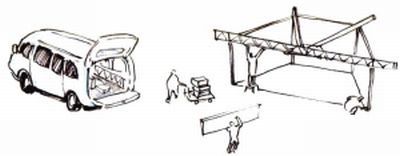 | |
| Fig. 1. Conceptual drawing of the portable VR system |
The system is composed of three sets of projectors and screens, which together can show a wide-view image 6.0m in width and 1.8m in height. Each LC projector has SXGA resolution (1280 x 1024 pixels). Thus the total resolution of the connected screens comes to about 3000 x 1000 pixels, which is nearly comparable vertically and much higher horizontally to that for high-definition (HD) video images (1920 x 1080 pixels). The three rendering computers that each controls one projector are connected to one another via Gigabit Ethernet. This broadband network allows rapid transfer of data for synchronizing images.
The projectors and screens are housed inside a frame given a hexagonal shape in order to make for easier assembly while also providing structural stability and economy of space. Front instead of rear projection was adopted to minimize lighting and space requirements. (Rear projection requires darkness and extra space behind the screen.) To avoid casting shadows of viewers on the screens, mirrors were installed to heighten the projection point without having to lift up the heavy projectors. The entire system, including the computers and other necessary hardware, can be installed in a space of 4m x 4m. The individual parts are small and light enough for a single person to carry, and the whole ensemble may be loaded into a minivan with a cargo space of 3.0m x 1.3m x 1.5m.
A plan and section of the system showing the hexagonal frame design and mirror projection method are given in Fig. 2a, Fig. 2b. The dismantling and assembling process requires less than two hours, thus reducing the burden of transporting the system from place to place (Fig. 3(a,b,c)). The setup holds 15 audience members at a time.
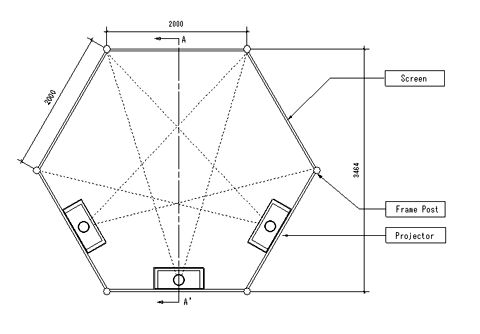 |
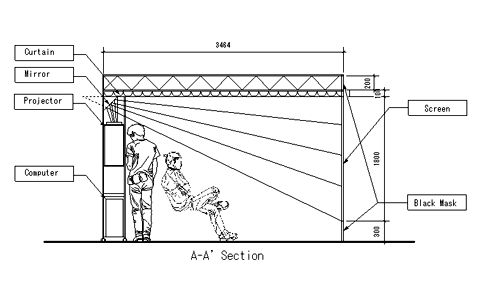 |
|
a) |
b) |
Fig. 2(a,b). Physical features of the portable VR system - a)plan and b)section
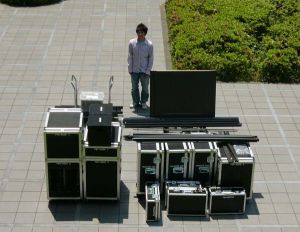 |
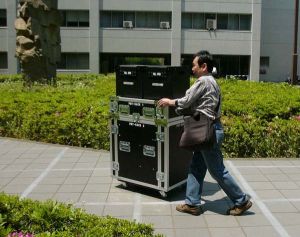 |
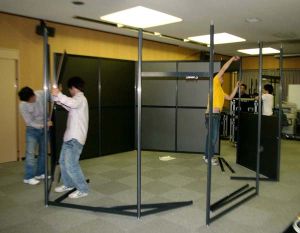 |
|
a) |
b) |
c) |
Fig. 3(a,b,c). Process of transporting/assembling the portable VR system
Disaster-education Contents for the System
Movie and still images
As contents for the system, we are developing two types of materials for disaster education. The first is a set of high-quality movie and still images of past disasters such as the 1995
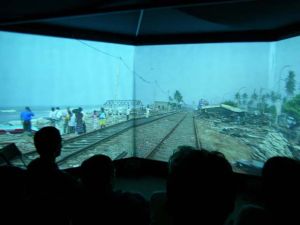 |
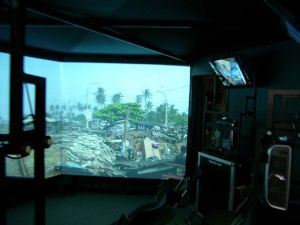 |
|
a) |
b) |
Fig. 4(a,b). Movie and still images projected on the wide screen
Real-time computer-graphics images
The other program currently under development employs wide-angle computer-graphics images that synchronize data from three rendering computers. The images will present real-time physics simulations of object motion during an earthquake, in this way allowing participants to interactively examine the safety of their own rooms and reevaluate how they arrange their furniture.
Our simulator is a VR substitute for the “shaking room model” using scale-model furniture typically found at earthquake-education facilities such as the Disaster Reduction and Human Renovation Institution in Kobe (Fig. 5(a,b)). To use this tool, the participant first sets up some scale-model furniture in the room, then turns a handle and shakes the room to see the damage that can be caused by inappropriately placed furniture. The simulator makes it easy to see, for example, that tall furniture that could collapse across a wide portion of the room should not be installed near sitting or sleeping areas. Thus by trying out the model to evaluate the dangerousness of their own rooms during an earthquake, participants are encouraged to rearrange their furniture in safer ways.
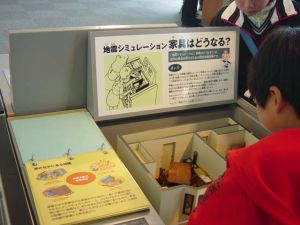 |
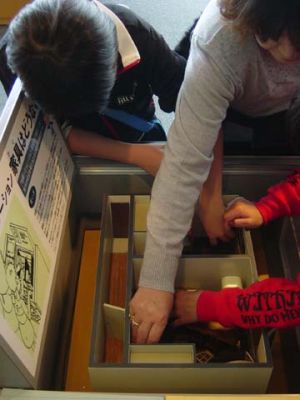 |
|
a) |
b) |
Fig. 5 (a,b). Earthquake-education tool that makes use of real-scale models to show how furniture collapses during an earthquake (Disaster Reduction and Human Renovation Institution in Kobe)
This hands-on simulator is quite popular at earthquake-education facilities because it is fun and clearly illustrative and therefore highly effective. Replacing actual scale models with virtual reality, as in our program, should lead to several advantages, making it possible:
- to simulate different types of rooms and furniture layout;
- more precisely control seismic forces;
- use real-time physics simulation to depict object motion more accurately;
- to give participants an immersive visual experience that enhances the realism and immediacy of the demonstration.
Notwithstanding the many difficulties still involved, we are currently in the process of developing a room re-layout tool that manipulates furniture in a virtual room using a popup menu or force-feedback interface (Ryu et al., 2004).
Real-time physics simulation
A longtime challenge in the field of VR technology has been to depict object motion in a realistic manner capable of making viewers feel as if they are actually experiencing what they are seeing. Before the advent of real-time physics simulation, precalculated animated sequences were used to realistically portray the behavior of objects in a virtual environment. One obstacle to applying real-time physics simulation to virtual reality was calculation time, which was much too long to be able to create continuous movie sequences (Fig. 6(a,b)).
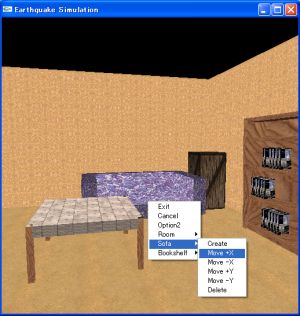 |
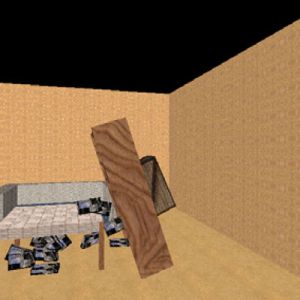 |
|
a) |
b) |
Fig. 6(a,b). Real-time simulator images of a room before and after an earthquake
The solution to this problem has been to have the engine simplify its calculation and lower accuracy so that it can render the scene at a rate acceptable for presenting a continuously moving image. Thanks to rapid advances in related algorithms and hardware, real-time physics simulation is now increasingly being incorporated into VR and game applications. The accuracy in object movement thus achieved greatly enhances viewers’ sense of “actually being there.”
A wide variety of physics engines are currently available, from open-source products such as ODE (Open Dynamic Engine), Bullet, and OPAL to commercial options such as Havok and PhysX (formerly called NovodeX). In our case, we chose PhysX for its performance stability and the availability of many developing-support documents to help us write new codes for our system. Using PhysX to calculate object motion will endow our images with greater realism and immediacy.
Conclusion
Our immersive VR system is very compact and portable and capable of presenting high-quality images. As contents for this system, we are developing a program that uses real-time physics simulation to show how furniture moves during an earthquake, thus encouraging participants to reevaluate the dangers present in their daily environment. Through this interactive program, it is expected that people will:
- be able to gain a more immediate experience of what it might be like to be in a disaster situation;
- be prompted to think about and recognize the risks of future earthquakes;
- be able to test effective measures for lessening earthquake damage.
In the future, we plan to upgrade our educational materials as well as work on the technical aspects of our furniture-manipulation interfaces. A follow-up survey of program participants will also be needed to evaluate the effectiveness of our system as compared to other text- or image-based educational media in prompting people to actually alter their living environments, which is, after all, what will be needed to mitigate damage from a real-life earthquake.
References
Architectural Institute of Japan (AIJ); Hanshin-Awaji daishinsai jutaku naibu higai chosa hokokusho (Report on damage inside houses during the Great Hanshin-Awaji Earthquake)// AIJ, 1996 (in Japanese)
Ryu, J.; Development of an effective tool for virtual experience of environmental hazards: A survey of disaster education facilities in
Ryu, J.; Multi-projection display system for architectural design evaluation/ Hasegawa, S., Hashimoto, N., and Sato, M.// Ninth Conference on Computer-aided Architectural Design Research in Asia (CAADIRA), 2004, Paper Number 81, pp. 901–910.















